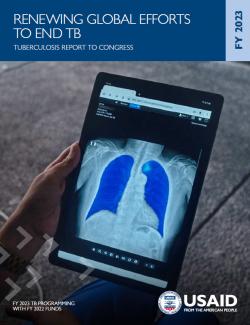After two years of COVID-19-related disruptions to TB prevention, diagnosis, and treatment efforts, 2023 had the highest number of people diagnosed and started on treatment since the beginning of the disease's global monitoring in 1995 that affected access to and provision of health services. – due in part to concerted efforts to recover from the pandemic’s devastating global impact. In 2022, global case notifications increased over the previous year, with 7.5 million, or 70 percent, of estimated incident cases diagnosed and started on treatment. This was a 16 percent increase in notifications from 2021 and a five percent increase as compared to 2019. TB mortality decreased by seven percent in 2022 compared to 2021 and was two percent lower compared to 2019, before the onset of COVID-19.
However, much work remains to achieve the Sustainable Development Agenda and USAID’s Global TB Strategy goals of ending TB as a major public health threat by 2030. Many individuals with TB are not appropriately diagnosed, despite a growing increase in the availability of rapid molecular tests.
In 2022, only 63 percent of reported TB cases were bacteriologically confirmed (similar to 2021), and only 47 percent of individuals with notified cases were tested with World Health Organization (WHO)-recommended rapid molecular tests (a 24 percent increase from 2021). These TB variants cause one-third of all deaths due to antimicrobial resistance (AMR), and remain a global public health challenge in that they are more difficult and expensive to diagnose and treat. Of those with DR-TB, 175,650 people (43 percent) started on treatment in 2022, representing a 26 percent increase compared to 2021. With newer, shorter, and better tolerated treatment regimens, the DR-TB treatment success rate (TSR) is increasing globally. The average drug-resistant TB TSR globally in 2022 was 63 percent–a five percent increase compared to the previous year, with individuals on the all-oral shorter regimen being even higher.
TB disproportionately affects populations impacted by poverty and drives individuals, families, and communities into further financial hardship. Globally, individuals with TB have to pay more than 20 percent of TB health care costs out-of-pocket. On average, individuals with TB and their households lose 50 percent of their annual income as they suffer from, and get treatment for, the disease—even where TB services are provided free-of-charge.
To make things worse, people with TB often also suffer from comorbidities and risk factors–including undernutrition, HIV infection, alcohol use disorders, smoking, and diabetes– making it harder to treat and cure them. TB persists, predominantly in low- and middle-income countries, due to lack of access to TB services, stigma and discrimination, financial constraints, socioeconomic determinants including poor living conditions and changing climate, and the slow development of new diagnostics, drugs, and vaccines.

